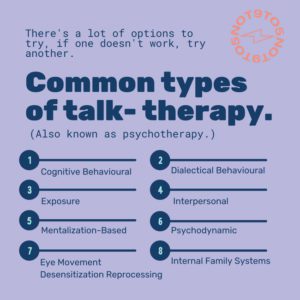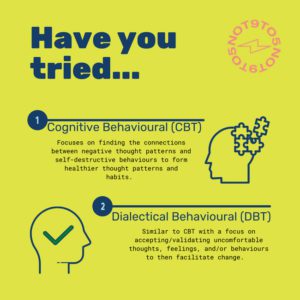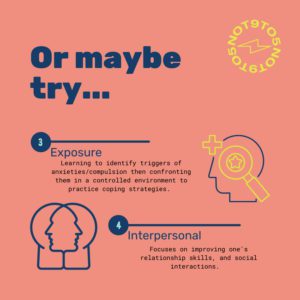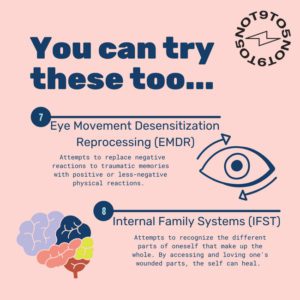Writer: Lisa Quigley
If you or someone you know is struggling with their mental health, psychotherapy can be an exceptionally beneficial practice. This list highlights the 8 most common types of talk therapy and is by no means exhaustive. There are so many different types and approaches to therapy. Finding the right kind of therapy, as well as the right therapist can be a journey, and it may take a few different stops to find the right one. Don’t let the process defeat or deter you- it will be worth it in the end. Never feel bad about deciding a certain type of therapy isn’t for you, there’s always more to try!
COGNITIVE BEHAVIOURAL THERAPY (CBT)
CBT is a form of psychotherapy that has proven effects for a wide range of mental illnesses including but not limited to depression, anxiety, substance use, and eating disorders. CBT’s foundational principles are that people suffering from psychological problems can learn better ways to cope with the unhealthy or unhelpful ways of thinking and patterns of behaviour, in turn relieving symptoms and leading more functional lives.
CBT is beneficial to learn how to independently acknowledge and change ones thought patterns and behaviours based on the work they do with the therapist. The therapy focuses on recognising distorted thought patterns and learning how to reevaluate them in light of reality, how to monitor and calm ones anxiety and mood, gaining a better understanding of the behaviour and motivations, and using problem-solving skills to handle hard situations.
CBT is useful to develop coping skills and adjust thought and behaviour patterns, however the focus is on what’s going on in the client’s present life, rather than what has led them to these difficulties. While some of the client’s history is needed, there is a lack in understanding of the developmental history behind such thoughts, behaviours, and mental illness. CBT may be best used in conjunction with a form of therapy that has a stronger focus on the root causes of the client’s mental illness.
[1]https://www.apa.org/ptsd-guideline/patients-and-families/cognitive-behavioral
DIALECTICAL BEHAVIOURAL THERAPY (DBT)
DBT is a modified version of CBT where it teaches people how to develop healthy ways to cope with stress, live in the present moment, regulate emotions and improve relationships. DBT was originally used for Borderline Personality Disorder (BPD) but has been adapted to treat an array of mental illnesses, including PTSD and those with issues of emotional regulation and self-destructive behaviours such as eating disorders or substance abuse. The term ‘dialectical’ refers to the interaction of two conflicting ideas: acceptance and change.
The patient and therapist work together to resolve this contradiction between ‘self-acceptance’ and change through strategies such as mindfulness, distress tolerance, interpersonal effectiveness, and emotional regulation. These practices, in addition to traditional CBT treatment, help to create effective positive change in the patient’s emotions, responses and relationships. DBT has four components: individual therapy, group therapy, phone calls, and weekly consultations between DBT therapists to make sure protocol is being followed for all patients. DBT has proven more effective than CBT, especially for patients suffering from BPD.
[2]https://www.verywellmind.com/dialectical-behavior-therapy-1067402 [3]https://www.verywellmind.com/cbt-dbt-treating-borderline-personality-disorder-425195
EXPOSURE THERAPY
Exposure therapy was invented to help address the associations and break the patterns of avoidance one has with their fears. The individual is ‘exposed’ to their fear in a controlled, safe environment to eventually decrease fear and avoidance. It has been demonstrated to help individuals with fears ranging from phobias, social and general anxiety disorder, to obsessive-compulsive disorder and PTSD.
There are many methods to this, including imagination techniques, sensational techniques, or ‘in vivo exposure,’ direct exposure to the feared object or environment. These methods can be conducted in different approaches, such as ‘flooding’ where you follow the exposure hierarchy, starting with the most difficult tasks, and ‘graded exposure’ which follows the same principle as flooding, except you start with the mildly feared object and work your way up. There is also systematic desensitization, which is when the fear is paired with relaxation techniques to make them feel more comfortable and manageable.
Exposure therapy can help to decrease or change the habits/ rituals an individual has around a fear. It can also help to build the patient’s self-efficacy with confrontation, reaction, and how they process the emotions associated with the fear and develop more realistic beliefs toward it.
[4]https://www.apa.org/ptsd-guideline/patients-and-families/exposure-therapy
INTERPERSONAL THERAPY (IPT)
IPT is an attachment-based, problem-focused treatment for relationship problems and depression. The focus is on current relationships and interpersonal events that contribute to symptoms of mental illness. It does not address the history of the individual, however it is informed by their past and current patterns of relating. It focuses on key issues in one of three areas including recent life changes or transitions, conflicts with others, or grief related to loss of a significant other. It aims to relieve symptoms of distress by helping an individual understand and improve relationships in their life, their social support, and adjust to specific life changes.
IPT aims to develop awareness and make changes to your interpersonal behaviours in order to resolve current problems through highly structured, brief therapy. A patient will have 12-20 sessions where they concentrate on a specific problem area with the support of the therapist. The patient will learn how to evaluate their role in the relationship/conflict, how to be aware of and manage their own expectations and needs, and how to communicate effectively. In grief or transition IPT, the individual learns to mourn the loss, adapt to new circumstances and make use of more social support.
[5]https://www.camh.ca/en/health-info/mental-illness-and-addiction-index/interpersonal-psychotherapy [6]https://torontopsychologycentre.com/approach/interpersonal-therapy/
MENTALIZATION-BASED THERAPY (MBT)
MBT is a long-term psychotherapy that helps to make sense of our thoughts, beliefs, desires and feelings and how they influence our behaviours and interpersonal interactions. It aims to stabilize ones sense of self and identity by learning how to manage their thoughts and emotions coherently, maintain satisfying relationships, and effectively respond to their own and others’ experiences. It is most commonly used for those with personality disorders or those who suffer from long-term difficulties in relationships and experience intense, overwhelming emotional distress that results in self-destructive behaviour or aggression towards others. It is also useful for those who are distrustful of others or struggle to read other people’s responses to them.
The focus is on present conflicts and daily life interactions to help improve your understanding of yourself and others. This is done through extensive group therapy, followed by individual sessions. The goal is to sustain the mentalization process so that an individual may eventually be able to develop and uphold self-reflective insights and behavioural change.
[7]https://www.psychiatrictimes.com/view/mentalization-based-treatment-common-sense-approach-borderline-personality-disorder [8]https://tavistockandportman.nhs.uk/care-and-treatment/treatments/mentalisation-based-therapy/
PSYCHODYNAMIC THERAPY
Psychodynamic therapy is the psychological interpretation of mental and emotional processes to improve an individual’s life. This is done by recognizing response patterns and how one’s behaviour may be influenced by unconscious thought. The patient gains insight to their lives and present-day problems by discussing emotions, thoughts, beliefs, and early-life experiences.
The therapist encourages ‘free association,’ which is when the client speaks freely about their emotions and fears. Psychodynamic theory believes this will reveal vulnerable feelings that may have been pushed out of conscious awareness and replaced with defense mechanisms such as denial, repression and rationalization. Being aware of how one avoids distress or has developed defense mechanisms to cope can provide insight into how early-life relationships affect them today, and can help to incite change in those patterns.
[9]https://www.goodtherapy.org/learn-about-therapy/types/psychodynamic#:%7E:text=Psychodynamic%20therapy%20is%20the%20psychological,less%2Dlengthy%20alternative%20to%20psychoanalysis.
EYE MOVEMENT DESENSITIZATION REPROCESSING (EMDR)
EMDR is proven to help people recover from trauma, distressing life experience and mental disorders such as PTSD, anxiety, depression and panic. While it is a method of psychotherapy, it does not focus on change to the emotions and behaviours associated with the distressing issue through speech. Instead, it is designed to resolve unprocessed traumatic experiences in the brain and allows the brain to resume it’s natural healing process by conducting bilateral stimulation (ex. eye movements, audio tones) while consciously focusing on the negative memory.
Our brains have a natural fight-flight-freeze-fawn instinct in stressful situations. Our brains also have a natural way to recover from stressful experiences via communication between the amygdala (alarm signal for threat), the hippocampus (learning and memory), and the prefrontal cortex (analyzes and controls behaviour and emotion). But sometimes traumatic experiences are not resolved naturally and need help to be processed. EMDR helps the brain process the memories and allows natural healing to resume, so while you can still remember the event, you do not have the overwhelming feeling of being back in that moment.
[10]https://www.emdria.org/about-emdr-therapy/
INTERNAL FAMILY SYSTEMS THERAPY (IFS)
IFS is based on the idea that individuals cannot be fully understood in isolation from the family unit and that each individual possesses sub-personalities, or ‘parts,’ and tries to understand and connect with these parts better to achieve internal and relational healing. Each part possesses its own personality and characteristics, which plays a role and contributes to the person’s internal family, or community. Some parts play healthy and productive roles, while others play problematic roles. The focus of the therapeutic work is on the problematic roles, while emphasizing that these parts may not be able to experience change in isolation from the network of relationships (family unit) they function in.
The goal is to reinstate recognition of who the individual is at the core by unburdening and restoring the person’s wounded parts to be able to establish trust with the healthy parts, thus creating acceptance and peace internally. Increased internal harmony often results in positive thoughts and behaviours in the individual’s external life. IFS is used in family, couple and individual counselling and may improve symptoms of panic, phobia, anxiety, depression, body image issues, and compulsion.
[11]https://www.goodtherapy.org/learn-about-therapy/types/internal-family-systems-therapy
It is easy to assume that all talk-based therapy is the same, and that all therapists work the same, so why not book the first available one you find? This approach to therapy makes sense on that basis of knowledge, however it is far from reality. As you can tell from the list above, many of the therapeutic strategies and the issues they address sound similar, but are actually quite different at the core. This can make that first leap into therapy daunting. Researching all the different types of therapy and associated professionals is especially exhausting if you already feel depleted from symptoms of mental illness and stressful life circumstance. The good news is that you are never ‘stuck’ with a therapist or method of therapy! It is a process, and exceptionally common to try multiple until you find the right fit. If you are feeling defeated from the journey, remind yourself of your courage and strength in taking that first step toward healing, wellbeing, and choosing yourself.
To read more about how therapy functions in the 7 components of mental health, click here.
To read a personal story about mental illness and the benefits of therapy and support, click here.
Check out our Instagram page for more info! https://www.instagram.com/not9to5_/
References








